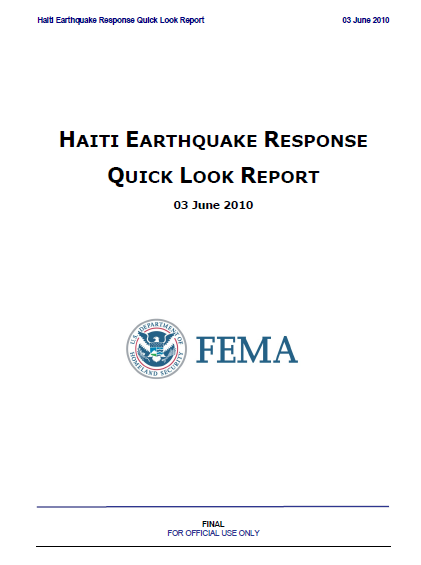 Haiti Earthquake Response Quick Look Report
Haiti Earthquake Response Quick Look Report
- 58 pages
- For Official Use Only
- June 3, 2010
EXECUTIVE SUMMARY
On Tuesday, January 12, 2010, at 4:53 p.m. Eastern Standard Time (EST), an earthquake with a 7.0 magnitude occurred in the Atlantic Ocean approximately 15 miles southwest of Port-au-Prince, Haiti. The nation suffered massive damage in Port-au-Prince and in numerous other towns and cities. According to the Government of Haiti, the earthquake collapsed 100,000 structures and damaged another 200,000 across Haiti, resulting in over 220,000 deaths, 300,000 injuries, and 1.1 million displaced people.
The United States (U.S.) Government, along with other nations, international organizations, and nongovernmental organizations, rushed to provide critical life-saving and other assistance to Haiti. President Barack Obama directed the U.S. Agency for International Development (USAID) to lead the coordination of the U.S. Government assistance to Haiti. USAID worked with other Federal agencies to organize and deliver assistance to the victims of the earthquake. The Department of Homeland Security (DHS) deployed over 1,000 personnel from various components to support U.S. assistance in Haiti. As of April 2, 2010, the U.S. Government had provided over $1 billion in assistance to Haiti.
FEMA negotiated an Interagency Agreement (IAA) with USAID to facilitate support to response operations. FEMA activated the National Response Coordination Center (NRCC) and deployed liaisons to other agencies’ operations centers to help coordinate the multi-agency relief effort. FEMA also activated eight Urban Search and Rescue (US&R) task forces and deployed four to Haiti to conduct search and rescue operations. These 4 task forces, combined with 2 task forces activated by USAID, were responsible for 47 of 134 live rescues in Haiti. The national US&R system includes 28 task forces, 2 of which have agreements with both FEMA and USAID (CA-TF2 and VA-TF1). In order to serve in foreign disasters, task forces must meet additional requirements identified by USAID. This report refers to task forces as either FEMA US&R or USAID Search and Rescue (SAR) depending on the activating agency.
By February 10, FEMA, in coordination with the Department of Defense (DOD), delivered more than 1.42 million meals; 24,365 blankets; 767,164 liters of water; 7,645 cots; and 94,709 comfort kits to Haiti.
…
Primary Areas for Improvement
This Quick Look Report identifies the following as primary areas for improvement that were demonstrated during the response to the Haiti earthquake:
- Additional FEMA US&R task forces should be prepared for deployment to a foreign disaster. FEMA and USAID should develop baseline requirements for any additional US&R task forces that may be identified for future foreign disaster deployments.
- FEMA US&R task forces and Incident Support Teams (IST) should complete USAID training on the foreign disaster response system, including command and control procedures. FEMA US&R teams should also become familiar with International Search and Rescue Advisory Group (INSARAG) guidelines and markings.
- FEMA should identify a single POC, the Emergency Support Function (ESF) 9 desk in the NRCC, to coordinate the movement of US&R task forces with the FEMA Movement Coordination Center (MCC), Logistics, and Transportation.
- FEMA should ensure that NRCC staffing is a priority and should increase the number of full-time NRCC positions. FEMA should ensure that NRCC assignments are considered desirable by personnel.
- FEMA liaison standard operating procedures (SOP) should include travel authorization, deployment logistics, roles and responsibilities, pay, and other administrative issues that may be different from a typical disaster assignment. FEMA should provide liaisons with a “Smart Book” that contains all the critical information they will need during their liaison duty.
NRCC training should address higher-level collective tasks, including managing the center, planning for future operations, maintaining situational awareness, and providing resources to the field.
